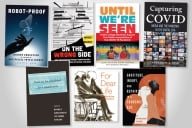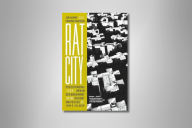You have /5 articles left.
Sign up for a free account or log in.
In 1991, Elliot L. Gilbert, chair of English at the University of California at Davis, went to the hospital for what ought to have been some fairly routine surgery. Mistakes were made. He died in the recovery room. His widow, Sandra M. Gilbert (also a professor of English at Davis), brought suit – a case finally settled out of court, but not before she piled up a mound of documents that gave her some sense of just what had happened. In Wrongful Death: A Memoir (Norton, 1995), she wrote: "Responsibility in the often miraculous but always highly technologized realm of modern medicine is so dispersed, so fragmented, that finally it accrues to no one."
Years earlier -- long before her work with Susan Gubar on the landmark work of American feminist literary criticism The Madwoman in the Attic: The Woman Writer and the Nineteenth Century Literary Imagination (Yale University Press, 1979) -- Gilbert had worked on a monograph she planned to call “‘Different, and Luckier’: Romantic and Post-Romantic Metaphors of Death.” The phrase in the title came from “Song of Myself,” in which Whitman declaimed that “to die is different from what anyone supposed, and luckier.”
A cosmic sentiment like that cannot do much to mitigate grief. But Gilbert dug the notes for that abandoned project out of her files, and has just published a remarkable book, Death’s Door: Modern Dying and the Ways We Grieve (also from Norton), which revisits her longstanding interest in elegy.
Calling Death’s Door a work of literary criticism, while accurate enough, seems very incomplete. Like Wrongful Death, it recounts the story of her husband’s death. It also offers a historical meditation on the emergence of what Gilbert calls the “technologies” of death and grief. (The famous “five stages” of confronting mortality, while originally meant as descriptive, now seems at times both prescriptive and somewhat compulsory. Woe to anyone who doesn’t follow the script.)
It is a rich book, and a deep one – and also, at times, somewhat terrifying to read, for it is the work of someone for whom “the denial of death” is simply not an option. While reading Death’s Door, I contacted the author to ask her a few questions. The following interview took place by e-mail.
Q:The book seems like a hybrid -- part memoir, part cultural history, part critical study. Those categories correspond reasonably well to the three big sections you've divided it into, but there are also margins of overlap. How did you come to understand just what kind of book Death's Door was turning out to be?
A: Yes, the book is indeed a kind of hybrid, or as my son put it, it's an attempt at "genre-bending." But I hadn't planned it that way. In fact, I began the work as a fairly traditional project in literary criticism. My goal was to explore what I called "the fate of the elegy" in the 20th century and beyond -- although even as I formulated that project the ambiguity of the word "fate" had begun to haunt me.
Did I intend to explore the evolution of the modern and contemporary elegy? Or did I want to explore modern ideas about fate in the elegy? If the latter, I was already moving beyond purely literary analyses into cultural studies. In any case, however, once I began researching and writing Death's Door it became clear to me that I was no longer able to do critical and scholarly work in the way I had.
As you've noted, following my husband's unexpected death in 1991, I felt compelled to tell his story -- including what I'd been able to reconstruct about the medical negligence that evidently killed him -- in my memoir, Wrongful Death. But the very mode in which I'd written that book, along with the elegiac poems clustered around it, had changed my way of writing. I had wanted to bear witness to my husband's loss of life and to my own grief. And now, as I began drafting Death's Door, I was still working in a testimonial mode, although with much greater self-awareness and, I think, with much larger ambitions, for now I was using my own case as an entry into meditations on the cultural formulations that shape our mourning and on the literary forms in which we mourn.
Of course, I should note here that, as a number of commentators have observed, beginning in the late 80's and 90's many academics in my own fields (literary studies, women's studies) had started writing autobiographically, testing their postulates, in effect, on their own pulses. So I wasn't alone in my sense that I needed a new and different way to approach my subject. And of course, as a feminist critic, I'd always argued that the personal was not only the political but the poetical.
Nonetheless, I suspect that the urgency of my need to "genre-bend" developed out of what I experienced, in early widowhood, as an urgent (indeed a surprisingly urgent) responsibility to testify about my own family's sorrow.
Q: One the one hand, you offer a phenemenology of death and grieving; that is, a description of the kinds of experience of care, fear, concern, etc. that seem to be just about as inescapable as mortality itself. On the other hand, you draw quite a bit on social and cultural history. That serves as a reminder that our vocabulary (and, to whatever degree, our experience) has been conditioned or "constructed." So at the risk of asking you to make an absurd choice: Which comes first? Which is definitive? The intimate level of experience or the social level of cultural meanings?
A: I think both are equally important but they're also inextricably related. As you point out, there's a phenomenology of death and grief that's as inescapable as mortality itself, and this manifests itself cross-culturally as well as trans-historically.
As I try to show in the book, almost every society imagines death as a kind of "place" that one enters, and all around the world people are haunted by what's often experienced as the nearness of the dead. (Are the dead on what George Eliot called -- in a different context -- "the other side of silence," merely separated from us by no more than "a thin piece of silk," as one of W.G. Sebald's narrators puts it?) Wherever we believe the dead mysteriously survive, many cultures have also experienced the dead as needy, often angry or sorrowful.
Throughout history, too, and worldwide, mourners have structured grief in special ways, elaborately patterning the prayers or diatribes with which the bereaved implore or reproach the gods, the fates, and the dead themselves. And again, almost everywhere the spouses -- especially the widows -- of those who die occupy a crucial place in ceremonies of grief. So these are all matters I investigate in the first major section of Death's Door, which takes as its intellectual starting point Zygmunt Bauman's comment that the omnipresence of "funeral rites and ritualized commemoration of the dead" along with the "discovery of graves and cemeteries" is thought by anthropologists to constitute "proof that a humanoid strain ... had passed the threshold of humanhood."
At the same time, as I argue throughout the second major section of Death's Door, history "makes" death, shaping both how we die and how we mourn. So our persistent human needs to imagine the fate of the dead and to pattern grief in special ways are formed, informed, and reformed by all kinds of cultural changes.
In most English-speaking nations, for instance -- and these are the societies that concern me most in the book -- the traditional visions of God and the afterlife that had already begun to disappear in the 19th century continued to erode throughout the 20th century, at least among the educated classes that produce poets, novelists, journalists, and film-makers. And as historians and sociologists from Phillipe Aries to David Moller have shown, everyone, no matter the class, dies differently now than in the past -- more privately yet often more technologically, in hospitals equipped with unnervingly complex machinery.
All of us, too, share a recent history of mass "death events," from the killing fields of the first World War to the Holocaust and Hiroshima in the second World War and on through Vietnam to the "shock and awe" of the present -- and surely this history has re-made our ideas of death and dying while changing our relationship to grief. The skeletons in the trenches of No Man's Land and the corpses charring in the crematoria of Auschwitz point down to an abyss of nihilism rather than up to heaven. But if we no longer hope for a redemptive heaven, then maybe we don't want to talk about death, maybe we need to deny its imminence.
Yet even while our theology and technology have grown increasingly nihilistic, we're quite literally haunted by images of the dead that refuse to leave us because they reside in celluloid or virtual permanence, populating our photo albums, movie screens, home videos, even digital libraries. How does this conflict between the real absence and the virtual presence of the dead change our modes of mourning?
Finally, then, as I worked on Death's Door I became increasingly conscious that the need to grieve whose urgencies I shared with mourners everywhere had a special 20th-century shape. For one thing (and this helped me understand a number of elegies I studied), I experienced my mourning as curiously embarrassing to many people I met, as if, because we fear death, we fear mourners too and suspect their sorrow might be somehow contaminating. In response to such embarrassment, I guess I sometimes become defiantly testimonial about my loss, both in prose (in Wrongful Death, for instance) and in poetry (in the elegies I published in my collection Ghost Volcano). And countless memoirists have done the same thing (most recently and famously Joan Didion) along with contemporary poets from Allen Ginsberg ( Kaddish) to Sharon Olds ( The Father), Ted Hughes ( Birthday Letters), and Donald Hall ( Without).
Q:The deep, dark core of the book is the contrast you make between "expiration" and "termination." It seems like that distinction is where the elements of memoir, cultural history, and literary analysis all link up.
A: "The deep dark core of the book." Thank you. That's a really incisive and insightful point because the basic argument of the book -- certainly the argument about the "fate of the elegy" -- began with my own experience of that distinction.
In chapter six, I tell the story of two episodes that powerfully moved me. In the first, the surgeon who was in charge of my husband's case testified that he had arrived at the hospital when his patient (my husband) was "terminating" -- i.e., dying. In the second, a nurse, more than three decades earlier, told me that my first child (a very premature baby who survived a few days) had "expired" -- i.e., died. After the doctor talked about "termination," the two words became so resonant for me that I brooded on them for quite some time.
To "terminate" is to come to a flat end. To "expire" is to breathe out something -- a breath that represents, perhaps, a soul. So each word seemed to me to have key metaphysical implications. "Termination," I decided, is modernity's definition of death; "expiration" the more traditional western (Christian) notion. For "termination" leads to Beckett, to what in Waiting for Godot Lucky calls "the earth abode of stones" while "expiration" empowers Milton, whose "Lycidas" has breathed out a soul that ultimately lands in heaven, where "entertain him all the saints above." So "termination" is terrifying, makes death almost unspeakably scary, and leads toward horror, repression, and denial, while "expiration" leaves us with some hope -- or anyway it used to.
Q:Your book isn't anti-technology, as such. But I did get the sense you were making the case for literature (and poetry in particular) as capable of providing something unavailable from the medical system. Almost an old-fashioned notion of the humanities as corrective -- if not to science, then to the scientistic or technocratic mentality. Or is that reading of your project off, in some way?
A: I'm not sure that I want to make a case for poetry, and more generally the humanities, as corrective, curative, or medicinal. But I do think I want to note that poets (and novelists and memoirists too, but especially poets) have refused to deny death and grief in a culture that finds these tokens of inescapable mortality at the least embarrassing because at the worst horrifying.
Poets testify, bear witness to the particulars of pain, the details of loss that technology flattens or sometimes even seeks to annihilate with words like "termination." I don't mean to suggest that those who work among the dying -- doctors in hospitals, medics on battlefields -- don't notice these details, but the language of science is in its way sedative, just as medicine's goals are (often appropriately) sedative and palliative. Poets remind us of what really happens. They don't take away the pain: on the contrary, they teach us how to feel it, to meet it, to know it.
Q:With all the quotations you incorporate, Death's Door serves (de facto anyway) as a kind of anthology. Was there a particular poem or passage that you recall as really being definitive for you? (In whatever way you'd construe "definative" as meaning: epiphantic, consoling, etc.)
A: No, there was no one poem that dramatized for me the practice of contemporary elegists, although there were several works that functioned for me as aesthetic manifestos -- most notably, perhaps, W.C. Williams's "Tract" (about "how to perform a funeral") and Stevens's "The Owl in the Sarcophagus" (about the "mythology of modern death" and its "monsters of elegy").
But before I began drafting Death's Door I had put together an anthology of traditional and modern elegies in a book called Inventions of Farewell, and in assembling this volume I found that, taken together, the elegies poets have produced from the mid-twentieth century onwards functioned for me as radiant examples of what I mean when I say that recent poets insist with unprecedented passion on the particulars of pain and grief.
Think of the resonant specifics Thom Gunn compiles in The Man with Night Sweats or, earlier, the details Ginsberg unflinchingly offers in Kaddish, Olds in The Father, Hall in Without. But I could go on and on about this historically "monstrous" elegiac genre, which dates back to the poems Wilfred Owen, Siegfried Sassoon and others sent back from the Front during the first World War or, even earlier, to Hardy's Poems of 1912. These writers won't let us forget -- as Tolstoy wouldn't either, in The Death of Ivan Ilyich --that death and its sorrows are often excruciating physical processes whose course usually binds and bends the spirit to the body's sufferings.
Such art may not be "consoling" in the traditional sense, but it consoles because it confronts pain and because in doing so it helps us accept loss, lets us know we aren't alone, and teaches us to hope that if we can articulate our suffering we can somehow master it or at least pass through and beyond it.








